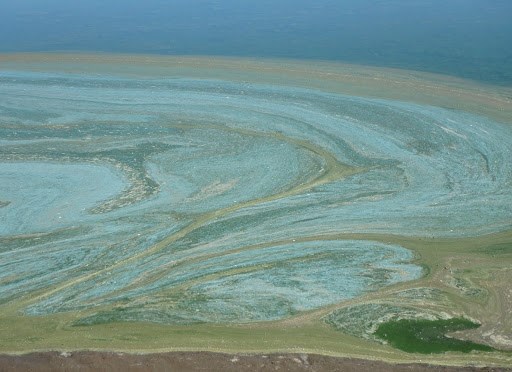Last updated: April 24, 2025
Article
Algae Blooms and Climate Change at Curecanti

NPS Photo / Gibney
Multiple species of blue green algae, also known as cyanobacteria, are native to our area of Colorado and are an essential part of the food web in Blue Mesa. In fact, cyanobacteria showed up about 2 billion years ago on the planet. Even though it has been around for billions of years, more and more lakes around the World are seeing bigger and more frequent blooms - Blue Mesa Reservoir included.
Big algal blooms of blue green algae can produce dangerous cyanotoxins under certain conditions. These cyanotoxins are particularly harmful toward pets and children, with a wide range of health effects including; rashes, nausea, seizures, and death. The National Park Service cannot predict where and when toxins will be present, as this is still a new topic being studied by the scientific community and is highly variable. Water testing also has a three-day turnaround time to get cyanotoxin results. Therefore, visitors to Blue Mesa should exercise caution around blue green algae, which looks like large floating algal mats, by avoiding body contact with the water.
Human-caused climate change is causing air temperatures to rise and stay warm longer in the summer. The growing season in Gunnison, CO has added 28 days since the 1980s showing this warming trend. This affects the surface temperatures of the water and warming areas in the reservoir ideal for algal growth.
Rising surface water temperatures and an overabundance of nutrients from agricultural runoff, fertilizer use, and human waste help these blooms grow. Every year we are adding more nutrients to the water adding to what has been deposited over the last 60 years since the filling of Blue Mesa. Blue Mesa is becoming a collection point of these nutrients making it a nutrient loaded reservoir.
Monitoring and studying the blooms as to when and where they appear will help us understand more about what conditions are ripe for cyanobacteria to occur. The NPS is partnering with the US Geological Survey to do remote sensing monitoring for harmful algae blooms. Project Underway to Identify Algal Toxins in US National Park Waterways - Natural Resource Stewardship and Science Directorate (U.S. National Park Service) (nps.gov) -
What can you do to help?
Participate in Bloomwatch bloomWatch | Cyanobacteria Monitoring Collaborative – Cyanobacteria Monitoring Collaborative (cyanos.org). Bloomwatch is a citizen science app to help find and record blooms. Helping understand and find algae will help us study what exactly causes cyanobacteria to form.
